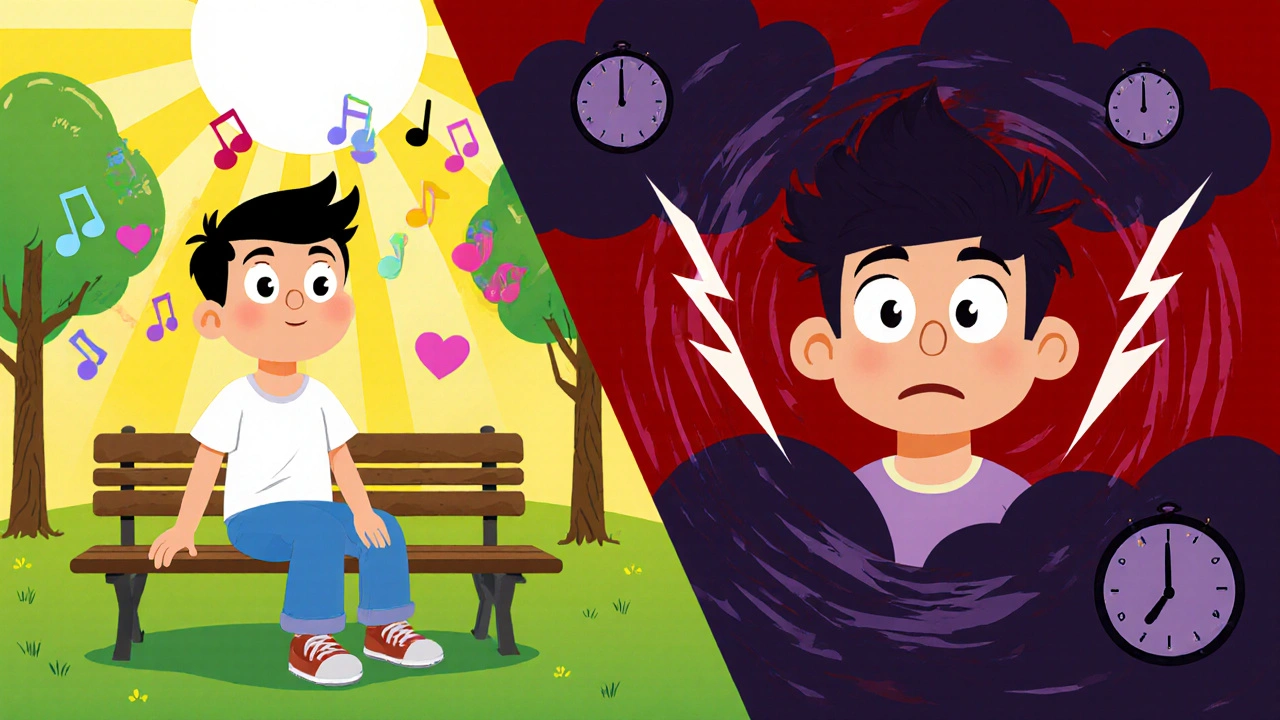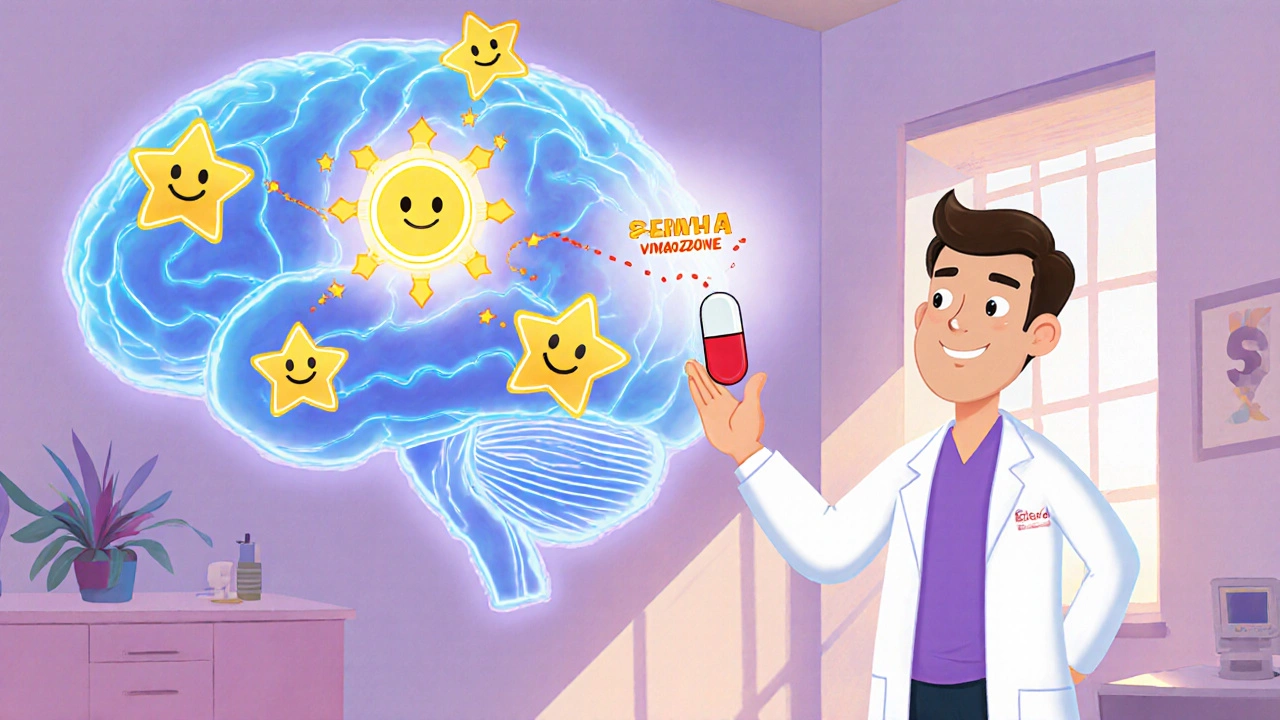Vilazodone Mania Risk Assessment Tool
Risk Assessment Guide
This tool estimates your risk of developing mania or hypomania when using vilazodone for bipolar depression. Based on clinical evidence, approximately 8-12% of bipolar patients experience manic switches with this medication.
Important: This is a screening tool only. Always consult your clinician for personalized medical advice.
Quick Takeaways
- Vilazodone is an antidepressant that also acts as a 5‑HT1A partial agonist.
- In bipolar patients it can lift depressive mood, but may trigger mania in susceptible individuals.
- Evidence from clinical trials is limited; most data come from case reports and small open‑label studies.
- When used, careful monitoring, low starting doses, and a mood stabilizer are key to safety.
- Discuss any history of rapid cycling or past antidepressant‑induced mania with your clinician before starting.
What Is Vilazodone?
Vilazodone is a prescription medication classified as a serotonin‑modulating antidepressant (SMA). It combines selective serotonin reuptake inhibition with partial agonism at the 5‑HT1A receptor, giving it a dual mechanism that may improve mood faster than classic SSRIs. Approved by the FDA in 2011 for major depressive disorder, it is taken once daily, usually with food.
Understanding Bipolar Disorder
Bipolar disorder is a chronic mental‑health condition marked by alternating periods of depression and mania or hypomania. The depressive phase can feel like major depression, while the manic phase includes elevated mood, increased energy, reduced need for sleep, and risky behavior. Proper treatment aims to stabilize mood and prevent switches between states.
How Vilazodone Works in the Brain
Vilazodone’s primary target is Serotonin, a neurotransmitter that influences mood, anxiety, and sleep. By blocking the serotonin transporter (like an SSRI), it increases serotonin levels in the synaptic cleft. Simultaneously, its partial agonist action at the 5-HT1A receptor may dampen excessive serotonergic firing, theoretically reducing anxiety and the risk of mood destabilization.

Potential Benefits for Bipolar Depression
Because bipolar depression often responds poorly to standard mood stabilizers alone, clinicians sometimes add an antidepressant. Vilazodone’s unique profile offers a few possible advantages:
- Faster onset of action - Some open‑label studies reported noticeable mood lift within 2‑3 weeks, shorter than typical SSRI timelines.
- Lower sexual side‑effect burden - Compared with traditional SSRIs, patients often report fewer libido issues, an important quality‑of‑life factor.
- Anxiolytic effect - The 5‑HT1A activity can ease co‑occurring anxiety, which frequently aggravates depressive episodes.
These benefits, however, are modest and highly individual.
Risks and Safety Concerns
Adding any antidepressant to a bipolar regimen carries the danger of a "manic switch." The data for vilocazodone specifically show:
- Approximately 8‑12% of bipolar patients in small trials experienced emergent mania or hypomania.
- Rapid cyclers (those who shift between states quickly) appear especially vulnerable.
- Common side‑effects include nausea, diarrhea, and headache-issues that can exacerbate depressive fatigue.
Because vilazodone is metabolized by the liver enzyme CYP3A4, drug‑drug interactions with mood stabilizers like Lithium are minimal, but caution is warranted with antiepileptics (e.g., carbamazepine) that induce CYP3A4.
What the Evidence Says
| Study Type | Sample Size (Bipolar) | Primary Outcome | Mania Switch Rate |
|---|---|---|---|
| Randomized Controlled Trial (RCT) | 45 | Improvement in Hamilton Depression Rating Scale | 10% |
| Open‑Label Extension | 78 | Sustained mood elevation over 12 weeks | 7% |
| Case Series | 12 | Rapid response in treatment‑resistant depression | 0% (selected stable patients) |
Overall, the evidence base is thin. Large‑scale RCTs that directly compare vilazodone with other antidepressants in bipolar populations are still missing. Clinicians therefore rely on extrapolation from major‑depression studies and real‑world observations.
Practical Tips If You or a Loved One Is Considering Vilozodone
- Start low, go slow - Begin with 10 mg daily for the first week, then increase to 20 mg if tolerated.
- Never use alone - Pair with a proven mood stabilizer (e.g., lithium, valproate, or an atypical antipsychotic like Quetiapine).
- Monitor weekly for at least the first 6 weeks - Watch for signs of racing thoughts, reduced need for sleep, or impulsive spending.
- Report side‑effects early - Gastrointestinal upset often subsides after the first two weeks, but persistent nausea may need a dose adjustment.
- Consider genetic testing - If you know you have a CYP3A4 variant, dosage may need tweaking.
These steps help balance the potential uplift in depressive symptoms with the ever‑present risk of a manic switch.
Bottom Line: Weighing the Pros and Cons
Vilazodone offers a novel approach that can help some bipolar patients break through stubborn depressive phases while causing fewer sexual side‑effects. Yet the risk of triggering mania, especially in rapid cyclers, remains real. Vilazodone bipolar disorder is best reserved for individuals who have not responded to standard mood stabilizers and who can commit to close monitoring.
Frequently Asked Questions
Can vilazodone be used without a mood stabilizer?
No. In bipolar disorder, guidelines recommend that any antidepressant, including vilazodone, be paired with a mood stabilizer to reduce the chance of a manic switch.
How long does it take to see an effect?
Some patients notice mood improvement within 2-3 weeks, but full therapeutic effects often take 6-8 weeks.
What are the most common side‑effects?
Nausea, diarrhea, headache, and occasional insomnia. Sexual dysfunction is less frequent than with classic SSRIs.
Is vilazodone safe during pregnancy?
Safety data are limited. The FDA classifies it as Category C, meaning risk cannot be ruled out. Discuss alternatives with your obstetrician.
Can I switch from another antidepressant to vilazodone?
A gradual cross‑taper is recommended. Typically, you lower the current drug over 1-2 weeks while introducing vilazodone at 10 mg daily.


Penny Reeves
October 19, 2025 AT 21:09While the article drifts through the basics, it glosses over the nuanced pharmacodynamics of vilazodone, which frankly deserve a deeper exposition. The assertion that it "may lift depressive mood" is overly simplistic given the heterogeneity of bipolar phenotypes. Moreover, the piece neglects to stress the importance of pharmacogenomic profiling, a glaring omission for any self‑respecting clinician.
Sunil Yathakula
November 2, 2025 AT 18:29Hey there, I totally get how confusing it can be to juggle mood stabilizers and an antidepressant. If you decide to give vilozodone a try, make sure you have a buddy or family member who can keep an eye on any sudden mood spikes. It really helps to have that support system, especially during the first few weeks.
Catherine Viola
November 16, 2025 AT 15:49It must be observed that the presentation of vilazodone here is devoid of any mention of the covert influences exerted by pharmaceutical lobbying entities, which, in my estimation, subtly shape the narratives disseminated to practitioners. One cannot disregard the potential for undisclosed data suppression that may obfuscate the true incidence of manic switches. Consequently, a prudent clinician ought to remain vigilant and demand full transparency. The omission of such discourse appears intentional, bordering on the conspiratorial. I advise a thorough independent review of primary trial data.
sravya rudraraju
November 30, 2025 AT 13:09Allow me to elaborate on the practical considerations surrounding the initiation of vilazodone in bipolar depression, as the topic warrants a comprehensive discourse. First and foremost, the titration schedule should commence at a sub‑therapeutic dose of 10 mg per day, maintained for a minimum of seven days to gauge tolerability. Subsequent escalation to 20 mg should be contingent upon the absence of adverse gastrointestinal manifestations, such as persistent nausea or diarrhoea, which are frequently reported in the early phase of treatment.
Second, concurrent administration with a mood stabilizer-preferably lithium or valproate-cannot be overstated, for the prophylactic mitigation of manic induction remains the cornerstone of safety. The pharmacokinetic profile of vilazodone, being primarily metabolised via CYP3A4, necessitates a careful assessment of co‑administered agents that may induce or inhibit this pathway, thereby altering plasma concentrations.
Third, clinicians should implement a structured monitoring regimen, encompassing weekly assessments of mood polarity, sleep patterns, and impulsivity indices for at least six weeks. Utilising validated scales such as the Young Mania Rating Scale (YMRS) can facilitate early detection of sub‑threshold manic symptoms.
Fourth, patient education is paramount; individuals must be apprised of red‑flag signs-racing thoughts, diminished need for sleep, heightened risk‑taking behaviour-and instructed to report these promptly. This collaborative vigilance empowers patients to actively participate in their own therapeutic course.
Fifth, the potential benefits, namely a more rapid antidepressant response and a comparatively favourable sexual side‑effect profile, should be weighed against the documented 8‑12% incidence of emergent mania in trial cohorts. For patients with a history of rapid cycling, the risk may be amplified, thereby necessitating a more conservative approach, possibly opting for alternative agents with a lower propensity for mood destabilisation.
Finally, the decision to employ vilazodone should be tailored to the individual's treatment‑resistant status, factoring in prior antidepressant failures, comorbid anxiety, and personal preference regarding side‑effect burdens. In sum, a judicious, methodical, and patient‑centred protocol maximises therapeutic benefit while minimising iatrogenic risk.